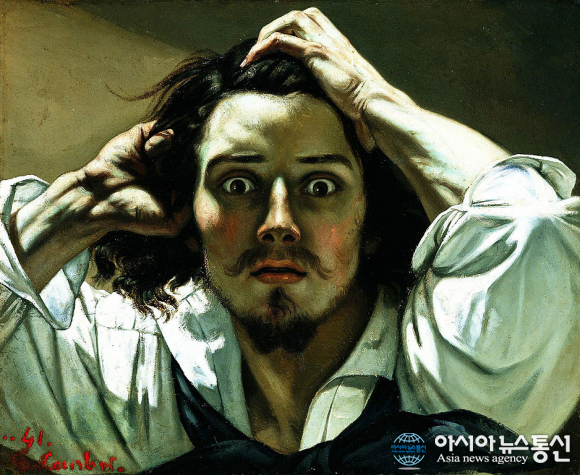 |
| Photo: "The Desperate Man" by Gustave Courbet via Wikimedia Commons |
For a long time, the relationship between mental illness and the creative mind has been the subject of debate among psychologists and neuroscientists. Whether they are correlated or causally connected, the number of artists who have suffered from mental illness are far numerous to dismiss the connection.
One contemporary example is one of Japan’s most famous living artist, Yayoi Kusama. She has a history of neurosis and is a voluntary resident of a mental hospital for four decades. Born in Matsumoto, Japan in 1929, Kusama grew up in an unhealthy family life. Her father was under the suspicion of womanizing, so Yayoi’s mother sent her to follow her father. Yayoi saw her father along with other women and has developed a strong revulsion towards sex.
She also grew up with her mother’s strong disapproval of her wanting to be an artist and had frequent fights with her. Yayoi said that it was at that time when her mental state was damaged. She then learned how to cope with her visual hallucinations and suicidal thoughts through drawing and painting repeated patterns to “obliterate” those thoughts. Later on, this coping mechanism is what she eventually call “art-medicine.”
After moving to New York in 1957, Yayoi found it a “fierce and violent place” and eventually found herself in poverty. During the 70s, she returned to Japan and became a resident of a mental hospital and since then, she has been creating her artworks under obscurity.
Kusama exhibited a form of neurosis that often manifests through her obsessive behavior towards polka dots. One of her exhibits entitled “Obliteration Room,” where visitors were invited to stick polka dots over a white living room. This obsession with repetitive patterns is the physical manifestation of her mental state. Her artworks are the reflection of an internal psychological tension that finds their way outside her self.
Every art form in any medium is a highly alienating piece every time a person looking at an artwork asks himself, “What am I looking at?” It is not enough to just say that it’s art, but rather, it is the amalgamation of the artist’s thoughts and emotions. However, the most prevalent pitfall of this kind of interpretation of art falls into pretentiousness and shallow obscurity.
New York psychologist Eric Dammann denies any form of causal relationship between artists and mental illness. To him, both can exist independently from each other since, “on one level, artists are dealing with the same problems as everyone else, such as mood disorders, insecurities, trauma,” and the only thing that magnifies these experiences is economic instability.
“Someone who studied accounting and is good at accounting is likely to get a well-paying job in an accounting firm, while a highly skilled artist can end up with nothing to show for all his hard work… In another field, you might find yourself doing the same thing over and over again, but at least you are doing something, while in the arts, by definition you aren’t doing anything, and that can be very traumatic,” Dammann added.
In her study entitled “Mental Illness and Creativity: A Neurological View of the ‘Tortured Artist,’” psychologist Adrienne Sussman establishes the link of similar brain activity between schizophrenia and manic depression. The results showed a hyperactive and unusual brain activity on the brain’s prefrontal cortex, which leads to “draw unusual connections between seemingly unrelated items or ideas, resulting in the delusions of the paranoid schizophrenic or mania.” Delusions, hallucinations, and thought disorders are often caused by the high dopamine levels in the said region of the brain that can make unusual connections to different things and ideas, which at some point can be creative or bizarre.
The study shows an analogous way of thinking between the neurotic and the creative mind: the drawing of unusual connections of things which can later on mix into a visual symbol or a metaphor.
The striking similarity of brain states on the neurotic and the artist draws an alternative perspective upon which we can relate mental illness to artistic creativity. The neurotic often falls short of expressing one’s feelings, since he or she is removed from the common collective reality. He perceives things differently, making him difficult to understand and may appear obscure to most people. On the other hand, the neurotic as an artist is able to express those feelings in a very alienating way through his or her art. This is one of the reasons why most art is inaccessible to people describing them as strange or shocking. Artworks done by mentally ill artists are the product of a distorted exposure from a reality different from the common collective.
These findings are predicated on incidental mutual relationships of mental illness and artistry. It is non-sequitur that all individuals that have mental illness are artistic and vice versa. One of the problems is the idea of the tortured artist to be romanticized, putting them on a pedestal of nobility under serious psychological circumstances. These artists are still suffering from psychological stress that must be addressed despite the great works that they have shared with us to reflect and contemplate about what comes as a passing thought in our daily waking life.

